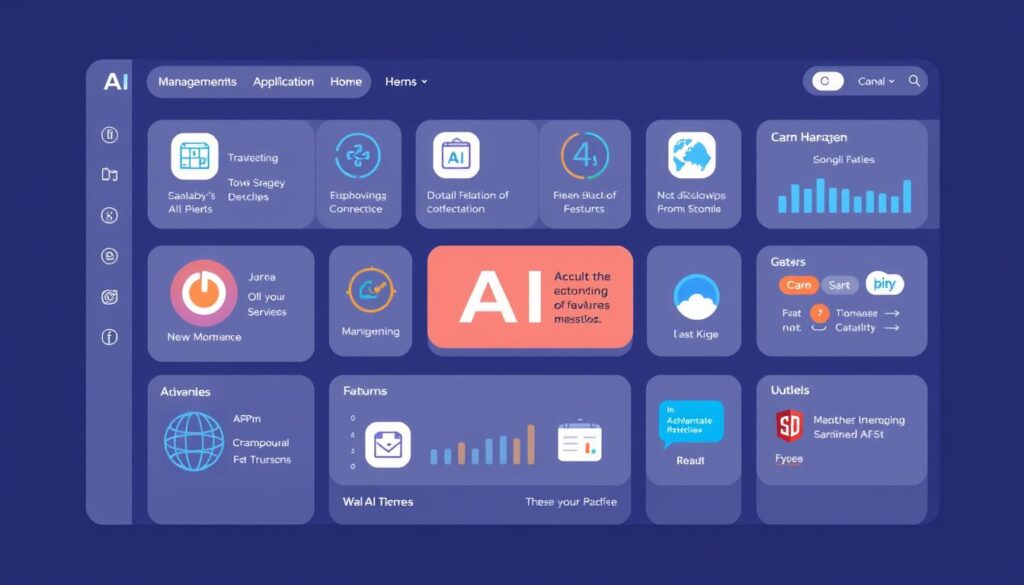Can you really generate substantial passive income by leveraging artificial intelligence without being an expert in the field?
The answer lies in understanding how to harness the power of AI tools to create sustainable financial streams with minimal ongoing effort. By automating complex tasks that previously required constant human intervention, you can unlock new revenue channels. For instance, you can explore various strategies to make passive income with, such as AI-powered affiliate marketing or creating and monetizing online courses.

By combining your expertise with the capabilities of artificial intelligence, you can create scalable business models that generate income while you focus on other pursuits.
Key Takeaways
- Discover how to transform your financial future using AI for sustainable passive income.
- Learn why AI technology is uniquely positioned to automate complex tasks.
- Understand the difference between using AI for active income versus building passive revenue systems.
- Explore the realistic income potential of various AI monetization strategies.
- Get an overview of the step-by-step approach to selecting and profiting from the right AI tools.
Understanding AI Tools for Passive Income
As you explore ways to diversify your income streams, understanding how AI tools can contribute to passive income is crucial. The potential of AI to automate and enhance various business processes makes it an attractive option for those looking to generate income with minimal ongoing effort.

What Are AI Tools and How Do They Work?
AI tools are software applications that utilize artificial intelligence to perform tasks that typically require human intelligence, such as data analysis, content creation, and customer service. These tools can be configured to work autonomously, making them ideal for creating passive income streams. By understanding how AI tools work, you can leverage them to make money more efficiently.
- Automate repetitive tasks, freeing up time for more strategic activities.
- Enhance decision-making with data-driven insights.
- Create personalized customer experiences, driving engagement and loyalty.
The Difference Between Active and Passive Income with AI
The key distinction between active and passive income lies in the level of ongoing effort required. Active income involves directly trading time for money, whereas passive income generates revenue with minimal effort, often through the initial setup of a system or business. AI tools can transform a traditional side hustle into a more automated business model, significantly reducing the time needed to maintain it.
By configuring AI systems to operate with minimal human intervention, you can create a steady stream of income that continues to generate value over time. This not only enhances your financial stability but also provides the freedom to pursue other interests and opportunities.
Why AI Is Perfect for Creating Passive Income Streams
The rapid advancement of artificial intelligence has opened up new avenues for generating passive income. As AI technologies continue to evolve, they are being integrated into various industries, transforming the way businesses operate and creating new opportunities for entrepreneurs.
One of the key reasons AI is ideal for creating passive income streams is its
Automation Capabilities
. AI systems can automate repetitive tasks, freeing up time for more strategic and creative work. This automation capability allows businesses to operate efficiently, reducing the need for manual intervention and enabling the generation ofincomewith minimal ongoing effort.
Scalability Potential
is another significant advantage of AI in creating passive income streams. AI-powered businesses can scale rapidly without a proportional increase in costs or management time. According to Statista, the AImarketsize is predicted to reach $826.7 billion by 2030, indicating vast potential for growth andmaking moneythrough AI-driven ventures.

By leveraging AI’s automation and scalability capabilities, you can establish robust passive income streams. This not only enhances your financial stability but also provides the freedom to pursue other business opportunities or personal interests.
Essential AI Tools for Passive Income Generation
With the right AI tools, you can automate tasks and create a steady income flow. To get started, you’ll need to familiarize yourself with the various categories of AI tools available.

Content Creation Tools
Content creation is a crucial aspect of generating passive income, and AI tools can significantly simplify this process. Tools like AI-powered writing assistants can help you generate high-quality content quickly and efficiently. These tools can be used to create blog posts, social media content, and even entire ebooks.
Some popular content creation tools include AI Writer, Content Blossom, and WordLift. These tools use AI algorithms to analyze data and generate content that resonates with your target audience.
Design and Art Generation Tools
Visual content is equally important in attracting and engaging your audience. AI-powered design and art generation tools can help you create stunning visuals without requiring extensive design experience. Tools like Midjourney, DALL-E, and Prisma use AI to transform your ideas into professional-looking graphics and artwork.
These tools can be used to create custom graphics for your blog, social media, or marketing materials, enhancing your brand’s visual identity and appeal.
Automation and Workflow Tools
Automation is at the heart of creating passive income streams. By leveraging AI-powered automation and workflow tools, you can streamline your business processes, reduce manual labor, and increase efficiency. Tools like Make (formerly Integromat), Zapier, and ActivePieces enable you to connect various SaaS platforms and automate complex workflows.
These tools allow you to trigger actions based on specific events, creating fully automated business processes that run without your intervention. You can build complex automation sequences that handle everything from lead generation to customer follow-up and product delivery.
- Explore automation platforms that can connect AI tools with other software to create automated workflows.
- Learn how to build complex automation sequences that handle multiple tasks.
- Understand how workflow automation can connect multiple AI tools together, creating powerful systems.
- See how businesses are using these automation tools to eliminate repetitive tasks and create more efficient operations.
By integrating AI tools with automation and workflow tools, businesses can significantly enhance their operational efficiency and create scalable passive income streams.
AI Writing Services: Creating Content That Sells

As the demand for high-quality content continues to rise, leveraging AI writing tools can be a game-changer for creating a passive income stream. With the help of AI, writers can produce engaging newsletters, sales-oriented landing pages, and other types of content that drive revenue growth for clients.
Setting Up Your AI Writing Business
To get started, you’ll need to set up your AI writing business by investing in the right tools and developing your writing skills. This includes learning how to effectively use AI writing software to produce high-quality content. You’ll also need to establish a professional online presence, including a website and social media profiles.
Finding Clients and Scaling Your Operations
Finding clients is crucial to the success of your AI writing business. You can achieve this by leveraging freelance platforms, networking with potential clients, and offering competitive pricing. As your business grows, you can scale your operations by hiring other writers or investing in more advanced AI tools.
Pricing Strategies for Maximum Profit
To maximize your profits, you’ll need to develop a pricing strategy that takes into account the costs of using AI tools, your time, and other expenses. This could involve charging per-word rates, offering package deals, or using retainer arrangements. By understanding your costs and the value you bring to clients, you can set prices that deliver healthy profit margins.
By following these steps and continually adapting to the evolving AI writing landscape, you can build a successful AI writing business that generates significant passive income. With the right strategies and tools, you can make money by offering high-demand services and products to clients.
Developing AI-Powered Apps and Software
Leveraging AI in app development can significantly boost your productivity and open new revenue streams. By integrating AI into your development process, you can create innovative apps that stand out in the market.

Using AI Coding Assistants
AI coding assistants can significantly streamline your development process. They can help with code completion, debugging, and even suggest improvements, making your development process more efficient. This allows you to focus on creating high-quality products that meet your users’ needs.
By leveraging AI coding assistants, you can reduce the time spent on mundane tasks and allocate more resources to developing innovative features that drive business growth.
No-Code App Building with AI
No-code app building platforms that utilize AI are making it easier for individuals without extensive coding knowledge to develop sophisticated apps. These platforms provide drag-and-drop interfaces and AI-driven logic to create complex functionalities. This democratization of app development opens up new opportunities for entrepreneurs and small business owners to bring their ideas to the market.
Monetization Strategies for Your AI Apps
To make money from your AI-powered apps, you need a solid monetization strategy. Various models can be employed, such as subscription services, one-time purchases, and freemium offerings. Understanding your target audience and their willingness to pay is crucial in selecting the most appropriate model.
Additionally, implementing in-app purchases or premium features can drive additional revenue. Analyzing user behavior and market response using AI can help optimize your pricing and feature offerings, ensuring your app remains competitive and profitable.
AI-Generated Art and Design Business

Unlock the potential of AI-generated art to transform your creative passion into a thriving business. Artificial intelligence is constantly improving in design, editing, and visual elements, allowing you to create truly beautiful and unique pieces.
Creating Marketable AI Art
To succeed in the AI art business, focus on generating high-quality, unique digital artwork using tools like DALL-E or Midjourney. Understand your target audience and create art that resonates with them. Experiment with different styles and themes to develop a distinctive voice.
Consider the story behind your art and how it can connect with potential buyers on an emotional level. Storytelling can elevate your art from mere visuals to a compelling narrative.
Platforms to Sell Your AI-Generated Art
Several platforms can help you showcase and sell your AI-generated art. Online marketplaces like Saatchi Art and DeviantArt are popular among artists. You can also leverage social media platforms like Instagram to build a following and direct traffic to your sales platforms.
Additionally, consider creating your own website to have full control over the presentation and sale of your art. This can help in building a brand identity around your AI-generated art.
Building a Brand Around AI Art
Developing a distinctive brand identity is crucial for standing out in the competitive AI art market. Consistency in style, quality, and engagement across platforms can help build a loyal following. Be transparent about your creative process to address any concerns about the authenticity of AI-generated art.
Effective marketing strategies, including social media campaigns and collaborations, can further enhance your brand’s visibility and appeal. Learn from successful AI artists who have built recognizable brands that command premium prices for their work.
Building AI Chatbots for Business Clients

With the growing need for automated customer interactions, building AI chatbots for businesses is becoming a sought-after service. As companies strive to improve their customer service and reduce operational costs, the demand for effective chatbot solutions is on the rise.
Designing Effective AI Chatbots
To develop successful chatbots, you need to understand the specific needs of your business clients. This involves identifying their target audience, defining the chatbot’s purpose, and designing a user-friendly interface. Effective chatbots can help businesses automate tasks, provide 24/7 support, and enhance customer engagement.
When designing chatbots, consider the tone and personality that aligns with your client’s brand. This will help create a seamless and engaging experience for their customers.
Marketing Your Chatbot Services
To market your chatbot services effectively, focus on the benefits they offer to businesses, such as cost savings, improved customer satisfaction, and increased sales. You can also highlight the competitive edge that AI chatbots provide in today’s digital landscape.
Some key strategies for marketing your chatbot services include identifying high-demand industries like e-commerce, healthcare, and financial services, creating compelling case studies, and demonstrating the ROI of your chatbot solutions to potential clients.
By building partnerships with marketing agencies and other service providers, you can expand your reach and offer comprehensive solutions to businesses. This collaborative approach can help you tap into new markets and grow your chatbot development business.
AI-Powered Affiliate Marketing Strategies

By leveraging AI tools, you can significantly enhance your affiliate marketing strategies and increase your passive income. AI-powered affiliate marketing leverages artificial intelligence to enhance and streamline the process of promoting products and earning commissions.
AI tools can segment your audience based on preferences, behaviors, and demographics, ensuring your marketing efforts are directed toward the most relevant and potentially profitable customer segments.
Using AI to Find Profitable Niches
AI can help you identify profitable niches by analyzing market trends, consumer behavior, and competitor activity. This enables you to focus on areas with high demand and potential for growth.
With AI-driven tools, you can uncover hidden opportunities and stay ahead of the competition by making data-driven decisions.
Automating Content Creation for Affiliate Sites
AI can automate the creation of high-quality content for your affiliate sites, including product reviews, comparison articles, and more. This not only saves time but also ensures consistency and relevance.
By using AI content generation tools, you can produce content at scale while maintaining quality and authenticity that resonates with your readers.
Some key strategies for AI-powered affiliate marketing include: – Discovering how to use AI content generation tools to create high-converting affiliate content at scale. – Learning strategies for automating different types of affiliate content while maintaining quality. – Understanding how to use AI to create content frameworks and templates for multiple affiliate products. – Exploring methods for optimizing existing affiliate content for better search visibility and conversion rates.
Creating and Selling AI-Enhanced Online Courses

With AI, developing and marketing online courses has never been more efficient. You can leverage AI tools to create comprehensive online courses that cater to diverse learning needs.
Developing Course Content with AI
AI can be instrumental in creating the initial outline and content for your courses. By using AI, you can generate structured content that can then be refined based on your expertise. This approach not only saves time but also ensures that your courses are well-organized and relevant to your target audience.
For instance, AI can help in suggesting topics, creating quizzes, and even developing interactive elements for your courses. This enables you to focus on adding value through your insights and expertise, making your courses more engaging and effective.
Marketing and Selling Your Courses
Once your course is developed, AI can aid in creating targeted marketing campaigns to reach potential students. By analyzing data on learner behavior and preferences, AI can help you tailor your promotional efforts to maximize enrollments.
You can also use AI to create compelling sales pages, promotional videos, and social media posts that drive course enrollments. Furthermore, AI-driven analytics can help you refine your marketing strategies based on real-time feedback and performance data.
Platforms like Udemy, Teachable, and Thinkific can be leveraged to host and sell your courses with minimal ongoing management, making it easier to generate passive sales.
AI-Driven Dropshipping and E-commerce
The integration of AI in e-commerce is not just a trend; it’s a game-changer for dropshipping businesses. By leveraging AI tools, you can significantly enhance the operational efficiency of your online store, improve customer satisfaction, and ultimately drive more sales.

Setting Up an AI-Powered Online Store
To get started with AI-driven dropshipping, you need to set up an online store that can integrate AI solutions seamlessly. This involves selecting the right e-commerce platform that supports AI integrations, designing an intuitive user interface, and implementing AI-driven product recommendation engines.
AI can help you manage your product catalog by automatically updating product information, pricing, and inventory levels. Moreover, AI-powered chatbots can assist in handling customer inquiries, providing a more personalized shopping experience.
Automating Customer Service and Marketing
One of the significant advantages of using AI in dropshipping is the ability to automate customer service and marketing processes. AI-powered chatbots can handle common customer inquiries, process returns, and even provide product recommendations based on customer preferences and browsing history.
For marketing, AI can help create personalized campaigns targeting customers across various platforms, including email, social media, and advertising channels. By analyzing customer data and behavior, AI tools can optimize marketing efforts, leading to higher conversion rates and increased sales.
Furthermore, AI can aid in creating and scheduling social media posts that drive traffic to your online store. By automating these processes, you can focus on other critical aspects of your business, such as product sourcing and supplier management.
Ethical Considerations and Best Practices
As you integrate AI tools into your business operations, it’s crucial to consider the ethical implications and best practices to maintain trust with your clients and customers. While AI can significantly enhance your services and streamline processes, there are important ethical considerations to address.
The use of AI in generating content and providing customer service raises questions about quality, transparency, and the potential for misinformation. Ensuring that AI-generated content is accurate, relevant, and aligns with your brand’s voice is paramount.
Ensuring Quality in AI-Generated Content
To maintain high standards, it’s essential to implement a robust review process for AI-generated content. This involves:
- Regularly checking for factual accuracy and relevance.
- Ensuring the content aligns with your brand’s tone and messaging.
- Using AI as a tool to assist human creators, rather than replacing them entirely.
By doing so, businesses can leverage AI to enhance their content creation capabilities while maintaining the quality that their customers expect.
| Best Practice | Description | Benefit |
|---|---|---|
| Regular Review | Regularly review AI-generated content for accuracy and relevance. | Ensures high-quality content that aligns with brand standards. |
| Transparency | Be transparent with clients and customers about AI usage. | Builds trust and credibility with your audience. |
Transparency with Clients and Customers
Being open about the use of AI in your services is crucial for building trust. This involves clearly communicating how AI is used and ensuring that clients understand the benefits and limitations of AI-generated content.

By adopting these best practices, businesses can navigate the ethical complexities of AI integration, ensuring that they maintain strong relationships with their clients and provide high-quality customer service.
Common Challenges and How to Overcome Them
As you dive into the world of AI-driven passive income, you’ll inevitably encounter challenges that require strategic solutions. While AI offers numerous benefits, including automation and scalability, there are hurdles to navigate. Understanding these challenges and how to overcome them is crucial for maintaining a competitive edge in the passive income landscape.
Dealing with AI Limitations
One of the primary challenges with AI tools is their limitations. Despite their capabilities, artificial intelligence systems are not perfect and can struggle with tasks that require nuanced human judgment or complex decision-making. For instance, AI writing tools may produce high-quality content but can sometimes lack the subtlety or emotional depth that a human writer can provide. To overcome these limitations, it’s essential to understand the strengths and weaknesses of your AI tools. This involves testing their capabilities, identifying areas where they may fall short, and developing strategies to complement their limitations.

Staying Ahead of AI Technology Changes
The field of artificial intelligence is rapidly evolving, with new technologies and tools emerging regularly. Staying ahead of these changes is crucial for maintaining your competitive edge. To achieve this, you need to stay informed about the latest developments in machine learning, monitor industry trends, and be prepared to adapt your strategies as new technologies become available. This might involve regularly updating your AI tools, investing in ongoing education and training, and being open to experimenting with new approaches.
Conclusion
As we navigate the vast landscape of technological advancements, the potential for generating passive income through AI tools becomes increasingly accessible. By combining learning, experience, and the strategic use of these tools, you can create sustainable income streams with minimal effort.
To achieve success, it’s crucial to select AI monetization approaches that align with your skills, interests, and resources. A balance between automation and human oversight is necessary to maintain quality in your passive income systems. Starting small and scaling gradually allows you to refine your approach and adapt to the unique demands of your AI business model.
While AI tools can significantly reduce the workload required to generate income, initial setup and occasional maintenance are still necessary. Experimenting with different AI tools and approaches will help you discover your optimal passive income strategy. As AI technology continues to evolve, early adopters who combine technological advantages with human creativity and strategic thinking will be well-positioned for long-term success in the business of making money with AI tools.
Frequently Asked Questions (FAQ)
What are the most profitable AI tools for generating passive income?
Some of the most profitable AI tools include content creation software, design and art generation platforms, and automation and workflow management tools. These tools can help you create and sell digital products, offer services, and streamline your business operations.
How do I get started with using AI tools for passive income?
To get started, identify your niche and the type of passive income stream you want to create. Research AI tools that can help you achieve your goals, and start experimenting with different options. You can also take online courses or join communities to learn more about AI and its applications.
Can I use AI-generated content for my online business?
Yes, you can use AI-generated content for your online business, but it’s essential to ensure the quality and accuracy of the content. You should review and edit AI-generated content to make sure it meets your standards and resonates with your audience.
How do I price my AI-generated products or services?
Pricing your AI-generated products or services depends on various factors, including the value they offer to customers, the competition, and your target audience. You can research your market, analyze your costs, and test different pricing strategies to find the optimal price for your products or services.
What are the ethical considerations when using AI for business?
When using AI for business, you should consider the potential impact on your customers, employees, and the environment. Ensure transparency about your use of AI, and take steps to mitigate any potential biases or negative consequences. You should also prioritize data quality and security.
How do I stay ahead of the curve with AI technology changes?
To stay ahead of the curve, follow industry leaders and researchers, attend conferences and webinars, and participate in online communities. You should also continuously monitor and evaluate new AI tools and technologies to identify opportunities and potential applications for your business.
Can I use AI chatbots for customer support?
Yes, AI chatbots can be an effective way to provide customer support, helping you respond to customer inquiries, resolve issues, and improve customer satisfaction. You can integrate AI chatbots with your existing customer support systems to enhance your services.
How do I ensure the quality of AI-generated art and design?
To ensure the quality of AI-generated art and design, you should carefully review and curate the output, and consider factors like originality, aesthetics, and relevance to your target audience. You can also use human designers and artists to refine and enhance AI-generated content.

